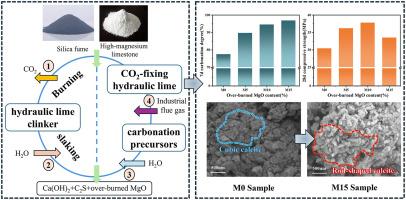Sustainable CO2-fixing hydraulic lime from high-magnesium limestone: mechanisms of strength enhancement, pore modification, and improved carbonation efficiency
IF 7.4
2区 工程技术
Q1 CONSTRUCTION & BUILDING TECHNOLOGY
引用次数: 0
Abstract
To address environmental challenges posed by greenhouse gas emissions and the depletion of non-renewable high-grade limestone, this study investigates the use of high-magnesium limestone (HMLS) with varying MgO contents for producing CO2-fixing hydraulic lime (CHL). The CHL consists of 0 %–15 % over-burned MgO (OM), 30 %–35 % Ca(OH)2, and 55 %–65 % β-C2S. The mechanical properties, phase composition, pore structure, and micromorphology of CHL were evaluated before and after accelerated carbonation (10 vol% CO2, simulating industrial flue gas). Results demonstrate that CHL containing 5 %–15 % OM exhibited coarsened pores and higher fractal dimensions compared to OM-free CHL, facilitating CO2 diffusion. This led to a 19.45 % increase in carbonation degree after 7 days and a 47.51 % improvement in compressive strength after 14 days. Additionally, OM altered CaCO3 crystallization from cubic to rod-like, enhancing pore densification and strength. Accelerated carbonation consumed OM, partially converting it to magnesium carbonate and Mg-calcite. QXRD analysis revealed that 5 %–6.7 % of the OM in carbonated CHL had reacted. Autoclave expansion tests (AET) showed no volume deformation or cracking in hardened CHL, with stable compressive strength for samples containing ≤10 % OM. This confirms the feasibility of utilizing HMLS with ≤26 % dolomite content. The study highlights OM's critical role in improving carbonation efficiency and microstructure, providing a sustainable pathway for HMLS's utilization and high-performance CO2-fixing binders.

高镁石灰石中可持续固二氧化碳的水力石灰:增强强度、孔隙改性和提高碳化效率的机理
为了解决温室气体排放和不可再生高级石灰石枯竭带来的环境挑战,本研究探讨了使用不同MgO含量的高镁石灰石(HMLS)生产固定二氧化碳的水力石灰(CHL)。CHL由0% ~ 15%的过烧MgO (OM)、30% ~ 35%的Ca(OH)2和55% ~ 65%的β-C2S组成。在加速碳化(10 vol% CO2,模拟工业烟气)前后,对CHL的力学性能、相组成、孔隙结构和微观形貌进行了评价。结果表明,与不含OM的CHL相比,含5% ~ 15% OM的CHL孔隙更粗,分形维数更高,有利于CO2的扩散。这导致7天后碳化度提高19.45%,14天后抗压强度提高47.51%。此外,OM使CaCO3的结晶从立方状变为棒状,增强了孔隙致密性和强度。加速碳化消耗OM,部分转化为碳酸镁和镁方解石。QXRD分析表明,碳化CHL中有5% ~ 6.7%的OM发生了反应。高压灭菌器膨胀试验(AET)表明,硬化CHL无体积变形或开裂,对于含OM≤10%的样品具有稳定的抗压强度。这证实了利用白云石含量≤26%的HMLS的可行性。该研究强调了OM在提高碳化效率和微观结构方面的关键作用,为HMLS的利用和高性能co2固定粘合剂提供了可持续的途径。
本文章由计算机程序翻译,如有差异,请以英文原文为准。
求助全文
约1分钟内获得全文
求助全文
来源期刊

Journal of building engineering
Engineering-Civil and Structural Engineering
CiteScore
10.00
自引率
12.50%
发文量
1901
审稿时长
35 days
期刊介绍:
The Journal of Building Engineering is an interdisciplinary journal that covers all aspects of science and technology concerned with the whole life cycle of the built environment; from the design phase through to construction, operation, performance, maintenance and its deterioration.
 求助内容:
求助内容: 应助结果提醒方式:
应助结果提醒方式:


